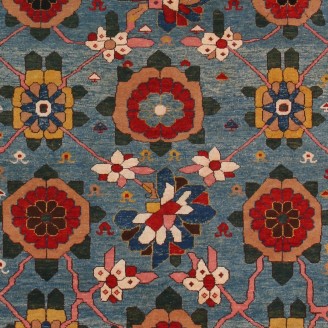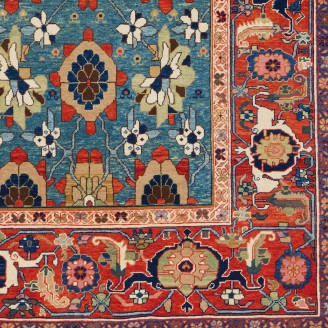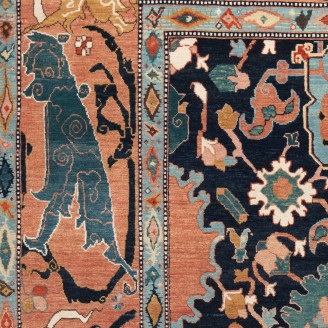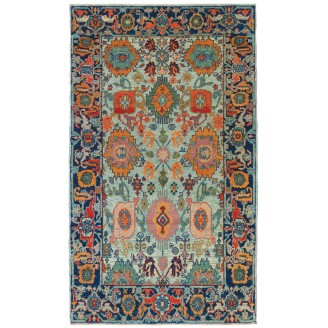COLLECTION OF BIDJAR RUGS
Roof of Iran. Showcases the exquisite artistry and durability of Persian weaving
Model: ART00454
Dimensions: 2'9" X 5'6"(84cm x 170cm)
The source of the rug comes from the book Antique Rugs of Kurdistan A Historical Legacy of Woven Art, James D. Burns, 2002 nr.4. This was an exclusive example of a Mina Khani lattice design mid-19th century rug from Koliya'i, Southern Kurdistan area. The mina khani is composed of a series of rows of..
Price:
$2,300
Ex Tax:$2,300
Model: ART00219
Dimensions: 4'1" X 5'9"(125cm x 176cm)
The source of the rug comes from the book Antique Rugs of Kurdistan A Historical Legacy of Woven Art, James D. Burns, 2002 nr.4. This was an exclusive example of a Mina Khani lattice design mid-19th century rug from Koliya'i, Southern Kurdistan area. The mina khani is composed of a series of rows of..
Price:
$0
Ex Tax:$0
Model: ART00382
Dimensions: 2'5" X 4'3"(74cm x 130cm)
The source of the rug comes from the book Antique Rugs of Kurdistan A Historical Legacy of Woven Art, James D. Burns, 2002 nr.2. This was an exclusive example of a Mina Khani lattice design mid-19th century rug from Koliya'i, Southern Kurdistan area. The mina khani is composed of a series of rows of..
Price:
$1,700
Ex Tax:$1,700
Model: ART00185
Dimensions: 1'9" X 3'0"(55cm x 93cm)
The source of the rug comes from the book Antique Rugs of Kurdistan A Historical Legacy of Woven Art, James D. Burns, 2002 nr.2. This was an exclusive example of a Mina Khani lattice design c. 1800s rug from Koliya'i, Southern Kurdistan area. The mina khani is composed of a series of rows of aster f..
Price:
$825
Ex Tax:$825
Model: ART00515
Dimensions: 5'8" X 8'0"(173cm x 245cm)
The source of the rug comes from the book Antique Rugs of Kurdistan A Historical Legacy of Woven Art, James D. Burns, 2002 nr.4. This was an exclusive example of a Mina Khani lattice design mid-19th century rug from Koliya'i, Southern Kurdistan area. The mina khani is composed of a series of rows of..
Price:
$8,960
Ex Tax:$8,960
Model: ART00306
Dimensions: 4'0" X 6'4"(124cm x 195cm)
The source of the rug comes from the book Antique Rugs of Kurdistan A Historical Legacy of Woven Art, James D. Burns, 2002 nr.4. This was an exclusive example of a Mina Khani lattice design mid-19th century rug from Koliya'i, Southern Kurdistan area. The mina khani is composed of a series of rows of..
Price:
$4,500
Ex Tax:$4,500
Model: ART00507
Dimensions: 5'0" X 6'9"(154cm x 207cm)
The source of the rug comes from the book Antique Rugs of Kurdistan A Historical Legacy of Woven Art, James D. Burns, 2002 nr.4. This was an exclusive example of a Mina Khani lattice design mid-19th century rug from Koliya'i, Southern Kurdistan area. The mina khani is composed of a series of rows of..
Price:
$6,280
Ex Tax:$6,280
Model: ART00252
Dimensions: 4'5" X 7'4"(135cm x 224cm)
The source of the rug comes from the book Seven Hundred of Oriental Carpets, Hanna Erdmann, University of California Press, 1971 pg.173. This offset pattern is composed of ascending shield-like palmettes flanked by leaf-like wings designed for 17th to 18th-century rugs from Azerbaijan, the North-wes..
Price:
$5,800
Ex Tax:$5,800
Model: ARTK0005
Dimensions: 4'4" X 7'9"(134cm x 237cm)
The source of the rug comes from the book Seven Hundred of Oriental Carpets, Hanna Erdmann, University of California Press, 1971 pg.173. This offset pattern is composed of ascending shield-like palmettes flanked by leaf-like wings designed for 17th to 18th-century rugs from Azerbaijan, the North-wes..
Price:
$0
Ex Tax:$0
Model: ARTW0001
Dimensions: 8'9" X 12'6"(267cm x 383cm)
The source of the rug comes from the book How to Read - Islamic Carpets, Walter B. Denny, The Metropolitan Museum of Art, New York 2014 fig.82. This was an exclusive example of a palmette lattice design 19th-century rug from Northwestern Persia. The design employs floral, richly complex repeating ar..
Price:
$0
Ex Tax:$0
Model: ARTW0003
Dimensions: 8'11" X 11'2"(274cm x 341cm)
The source of the rug comes from the book How to Read - Islamic Carpets, Walter B. Denny, The Metropolitan Museum of Art, New York 2014 fig.82. This was an exclusive example of a palmette lattice design 19th-century rug from Northwestern Persia. The design employs floral, richly complex repeating ar..
Price:
$0
Ex Tax:$0
Model: ART00016
Dimensions: 5'9" X 10'5"(177cm x 318cm)
This offset pattern is composed of palmettes and flowers, one has the impression that it is only part of a larger scheme designed for 19th-century rug from the Bidjar region, Eastern Kurdistan area. Very similar palmettes, drawn in a curvilinear manner and combined with identical forked leaves, can ..
Price:
$13,800
Ex Tax:$13,800
Model: ART00526
Dimensions: 4'9" X 6'7"(147cm x 202cm)
This offset pattern is composed of palmettes and flowers, one has the impression that it is only part of a larger scheme designed 19th-century rug from the Bidjar region, Eastern Kurdistan area. Very similar palmettes, drawn in a curvilinear manner and combined with identical forked leaves, can be s..
Price:
$6,200
Ex Tax:$6,200
Model: ART00277
Dimensions: 2'9" X 6'0"(86cm x 185cm)
This offset pattern is composed of palmettes and flowers, one has the impression that it is only part of a larger scheme designed 19th-century rug from Bidjar region, Eastern Kurdistan area. Very similar palmettes, drawn in a curvilinear manner and combined with identical forked leaves, can be seen ..
Price:
$2,900
Ex Tax:$2,900
Model: ART00585
Dimensions: 3'4" X 5'0"(104cm x 154cm)
This offset pattern is composed of palmettes and flowers, one has the impression that it is only part of a larger scheme designed for 19th-century rugs from the Bidjar region, Eastern Kurdistan area. Very similar palmettes, drawn in a curvilinear manner and combined with identical forked leaves, can..
Price:
$2,780
Ex Tax:$2,780
Model: ART00406
Dimensions: 2'11" X 4'11"(90cm x 152cm)
This offset pattern is composed of palmettes and flowers, one has the impression that it is only part of a larger scheme designed 19th-century rug from Bidjar region, Eastern Kurdistan area. Very similar palmettes, drawn in a curvilinear manner and combined with identical forked leaves, can be seen ..
Price:
$2,400
Ex Tax:$2,400
Model: ART00022
Dimensions: 1'7" X 2'9"(50cm x 84cm)
This offset pattern is composed of palmettes and flowers, one has the impression that it is only part of a larger scheme designed 19th-century rug from Bidjar region, Eastern Kurdistan area. Very similar palmettes, drawn in a curvilinear manner and combined with identical forked leaves, can be seen ..
Price:
$620
Ex Tax:$620
Model: ART00418
Dimensions: 2'10" X 4'9"(88cm x 146cm)
This offset pattern is composed of palmettes and flowers, one has the impression that it is only part of a larger scheme designed 19th-century rug from Bidjar region, Eastern Kurdistan area. Very similar palmettes, drawn in a curvilinear manner and combined with identical forked leaves, can be seen ..
Price:
$2,000
Ex Tax:$2,000
Model: ART00102
Dimensions: 1'10" X 2'10"(56cm x 87cm)
This offset pattern is composed of palmettes and flowers, one has the impression that it is only part of a larger scheme designed 19th-century rug from Bidjar region, Eastern Kurdistan area. Very similar palmettes, drawn in a curvilinear manner and combined with identical forked leaves, can be seen ..
Price:
$825
Ex Tax:$825
Model: ART00405
Dimensions: 2'7" X 8'7"(80cm x 264cm)
This offset pattern is composed of palmettes and flowers, one has the impression that it is only part of a larger scheme designed 19th-century rug from the Bidjar region, Eastern Kurdistan area. Very similar palmettes, drawn in a curvilinear manner and combined with identical forked leaves, can be s..
Price:
$3,800
Ex Tax:$3,800
Model: ART00040
Dimensions: 6'0" X 9'2"(183cm x 280cm)
This offset pattern is composed of palmettes and flowers, one has the impression that it is only part of a larger scheme designed 19th-century rug from Bidjar region, Eastern Kurdistan area. Very similar palmettes, drawn in a curvilinear manner and combined with identical forked leaves, can be seen ..
Price:
$0
Ex Tax:$0









































